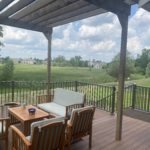Attached Vs. Free-Standing Pergolas: What’s Best for Your Home?
Choosing between an attached pergola and a free-standing pergola can be challenging. Both types enhance outdoor living spaces but serve different needs. An attached pergola extends from the house, offering a seamless transition to outdoor areas. A free-standing pergola stands alone, offering flexible placement in the yard. This article will help homeowners decide which pergola type, whether attached or free-standing, best fits their outdoor setting and lifestyle needs.Key Features and Styles of Pergolas
Pergolas are architectural features that enhance outdoor living spaces by providing additional shade and appeal. They serve various functions, from defining dining areas to creating cozy garden nooks. Available in many styles and materials, pergolas can be customized to fit any landscape or personal taste. There are three common materials used in pergola construction:- Wood: Wood pergolas are classic and blend with natural surroundings, offering a warm and inviting ambiance. They need regular maintenance such as staining or sealing to protect against weather elements and prolong their lifespan.
- Vinyl: Vinyl pergolas are a popular choice for their durability and low maintenance requirements. Unlike wood, vinyl does not fade, crack, or rot, making it ideal for those looking for a long-lasting structure without frequent upkeep.
- Aluminum: Aluminum pergolas are known for their strength and modern appearance. They resist rust and corrosion, making them suitable for various climates, especially those with high humidity or salt air. Aluminum pergolas can also be powder-coated for extra durability and color retention.
Attached Pergolas
Attached or wall-mounted pergolas are structures that connect directly to the exterior of a home. This integration allows for a seamless transition from the indoor living space to the outdoors, enhancing the architectural flow and functionality of the property. Typically, homeowners use attached pergolas to extend their living areas outside and create inviting spaces like outdoor kitchens or dining areas. These pergolas are ideal for hosting gatherings, allowing guests and family members to dine or relax under a shaded, sheltered area that feels like a natural extension of the home itself. They provide much-needed shade and can also be equipped with lighting and heating options, transforming them into year-round hubs for entertainment and relaxation.Benefits
Attached pergolas offer several advantages that make them a popular choice for homeowners, such as:- Cost-effectiveness: By leveraging the existing structure of the home for support, attached pergolas often require fewer materials and labor, making them more budget-friendly.
- Enhanced Structural Support: The connection to the home provides additional stability and durability, reducing the need for extensive groundwork and support structures.
- Seamless Aesthetic Transition: Attached pergolas blend with the home’s architecture and creates a unified look that smoothly transitions from indoor to outdoor environments. This integration helps maintain the style and design continuity of the living space.
Foundation and Footing Requirements
Attached pergolas capitalize on the structural support of an existing building as they use the home’s foundation to secure part of the pergola. This connection reduces the need for extensive foundation work, as the primary stability comes from the attached wall. Additional footings might be required for support posts that are not connected to the building, but these are generally less complex than those needed for entirely free-standing structures.Free-Standing Pergolas
Free-standing pergolas, also known as detached pergolas, are versatile structures that do not rely on any external support from a building. This independence allows them to be placed in a variety of outdoor settings. Their flexibility in placement makes them ideal for creating a focal point in a landscape, whether it’s over a blooming flower bed or as a standalone structure for climbing plants. These pergolas are commonly used to define and shelter specific areas such as outdoor dining spaces, tranquil garden retreats, or poolside lounges. Their standalone nature allows homeowners to craft unique outdoor living spaces wherever suits best, without the constraints of existing architecture.Benefits
Free-standing pergolas offer several distinct advantages:- Design Freedom: They provide complete creative control over design and materials, fitting any personal style or garden layout.
- Placement Versatility: Their standalone nature allows placement in diverse locations, from remote garden spots to central features in expansive yards.
- Diverse Location Choices: These pergolas are popular for a wide range of spaces as they can be installed anywhere outdoors.
Foundation and Footing Requirements
Freestanding pergolas need independent foundation systems due to their lack of attachment to other structures. The installation involves digging to set concrete footings at strategic locations, ensuring each pergola post is anchored. These footings must be deep enough to stabilize the structure against shifting soils and adverse weather conditions, such as wind-driven rain or snow loads.Choosing the Right Pergola for Your Home
When choosing the right pergola design for your home, consider a few key recommendations to ensure it meets your needs and complements your home’s style:- Attached Pergolas: Best for those looking to extend their living space seamlessly. Ideal if you want to enhance areas directly adjacent to your home, such as expanding an outdoor kitchen or creating a sheltered patio. These are cost-effective as they need fewer materials and leverage existing home structures.
- Freestanding Pergolas: Suitable for homeowners seeking flexibility and a statement piece in their yard. They work well in large spaces and can be placed anywhere, from garden centers to poolside. Although they might be a higher initial investment due to more extensive foundation needs, they offer greater design freedom.







